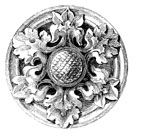
Previewing Mel Gibson’s Passion
CHRIST'S PASSION & GIBSON'S LYNCHING
In September of 2002, I presented a paper with slides to the Magnificat Congress in New York City. The subject of that paper was the impact of the visions of the 19th-century mystic Anne Catherine Emmerich on the arts, particularly in her graphic account of the Passion of Christ. It was a topic in which I had long been interested, both as an art historian and as a priest. Afterward, a knowledgeable and well-connected Jesuit came up to the podium and told me that actor Mel Gibson was planning to make a film on the very topic upon which I had just spoken, a movie that would portray the Passion of Christ through the lens of the Catholic mystic. While I immediately responded with surprise and excitement, the Jesuit tempered my enthusiasm with caution. He was in possession of the script, and he said that it was filled with difficulties. He later allowed me to look at it and see for myself.
When I read the script, my first impression was that it was exceedingly violent. But I was even more dismayed to find out that the movie was not drawing its inspiration exclusively from the visions of the stigmatic Sr. Emmerich. The Gibson film was also using some of the material left by another visionary nun, Mary of Agreda, who lived in the 17th century, and whose account of the Passion of Christ seemed to be based on an altogether different kind of mysticism, one that was more pious and fantastic than the comparatively newsreel-like story credited to Emmerich.
As with the problem of too many cooks in the kitchen, could a director mix his mystics and still come out with a product that was cohesive and compelling?
When I first read that now-outdated script, I certainly did not think so, but having just previewed a near-to-finished cut of the film, the answer is now a resounding yes. Mel Gibson will unveil to the public on Ash Wednesday of 2004 what must be the most powerful cinematic account of the Passion of Jesus Christ ever made. Certainly it is the most Catholic account ever brought to the screen. But the production has been fraught with peril and controversy, causing both the director and his lead actor, Jim Caviezel, to suffer considerably.
Before principal photography on the production began in Italy in the winter of 2002, I managed to have an hour-long interview with Jim Caviezel over the phone. Ever since I saw him in the film The Thin Red Line, it was obvious to me that he had the potential to play Jesus. Caviezel jokingly claims that Gibson chose him for the role because he was 33 years old and his initials are J.C. But there was more to it than that. The actor does have an ethereal presence on the screen, and an almost mystical stare that is enhanced by his penetrating eyes. Perhaps Gibson chose the actor because he has some of the same star quality that he himself exhibited in his earlier years. Now too old to play Christ, Gibson chose Caviezel in part because he would not provide cinematic history with yet another Nordic fair-haired Jesus. The actor’s dark looks will become overtly Mediterranean, and his blue eyes will be colored brown in the final version of the work.
You May Also Enjoy
Truffaut made five more or less autobiographical films, starting with "400 Blows" when actor Jean-Pierre Leaud was 14 and ending 20 years later.
A film entitled The Spitfire Grill has just been released. We have a fascinating insight…
His typical work is at times a beautiful blend of intuition, sensitivity, and compassion but at other times a maddening mixture of overly long scenes, aimless dialogue, and directionless plot.

